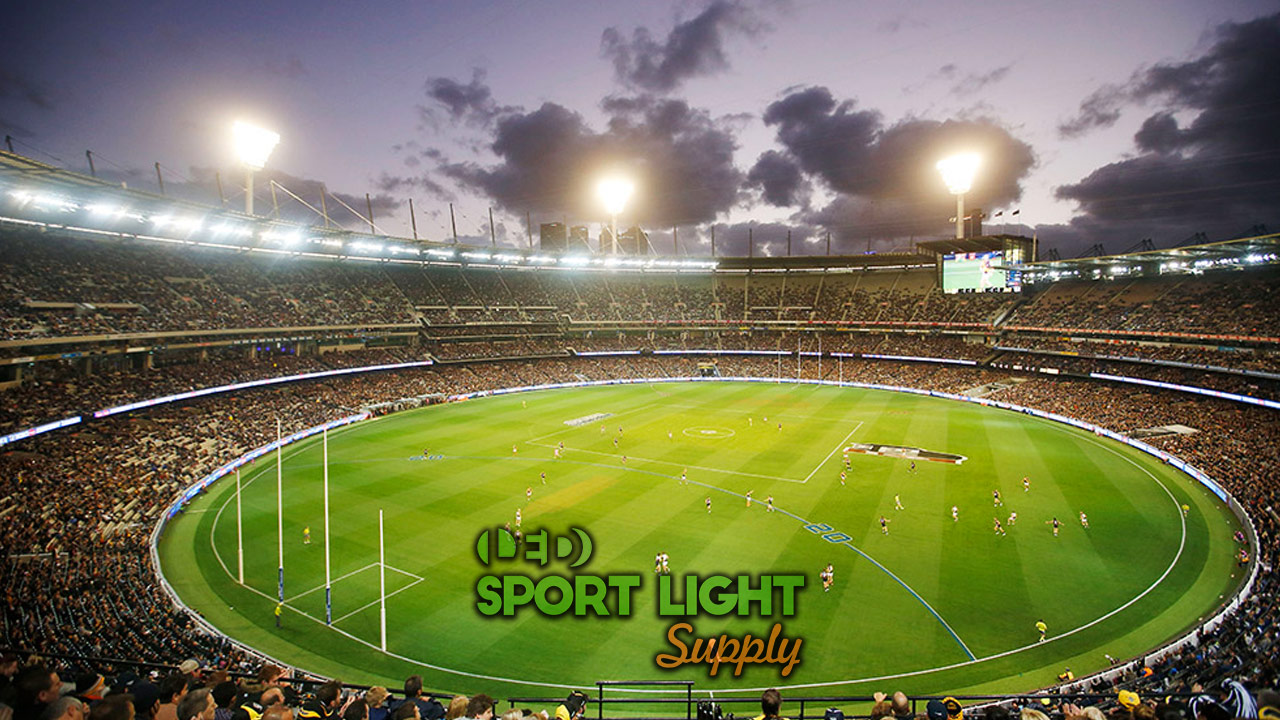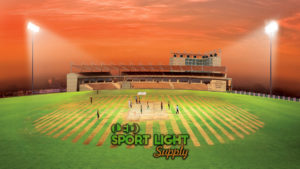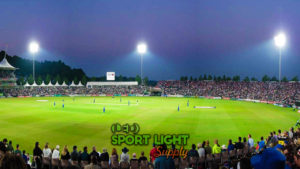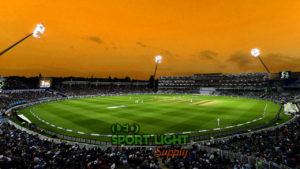The cricket field lighting design and layout can be tricky. Moreover, old sports facilities need an update. New cricket stadium owners might want to create one from scratch. A lot of adjustments might be in store during the realization of the project. So, a comprehensive guide is a perfect place to start or to catch up with the latest know-how.
In this unrivaled guide, you are going to find many explanations and examples. Cricket is a popular sport in India, South Africa, New Zealand, Pakistan, Bangladesh, Austria, and the UK. So, I am going to write several about the lighting standard for cricket activities in general. But I am also going to share the precise requirement for each level of competition. In this way, it will be easier for you to assimilate this info. Then, you can compare it with your local cricket association’s guidelines.
I am going to tackle the primary components first. After you know more about the latest LED lights available on the market, I will expand more on other topics that relate to the cricket ground.
What is a cricket stadium lighting system?
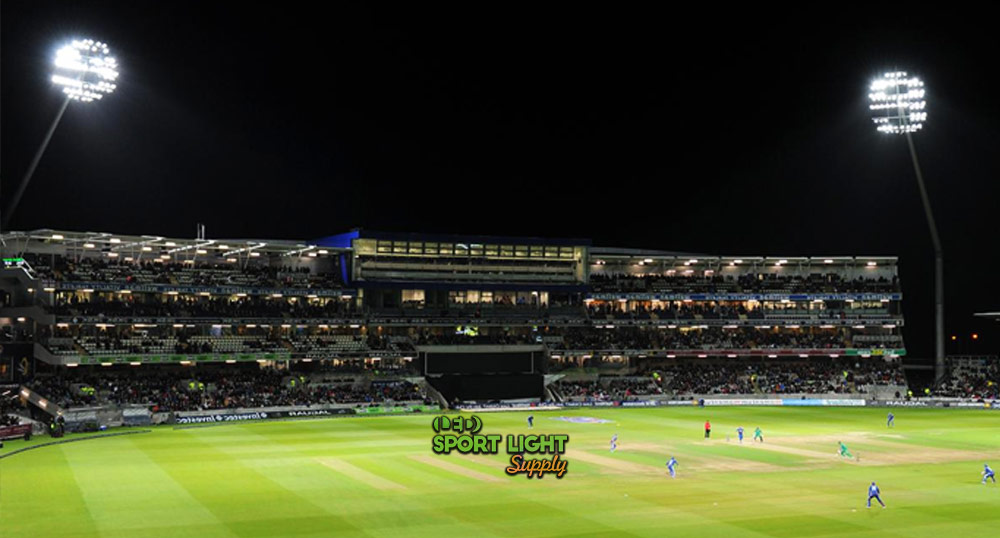
In a few words, a cricket stadium lighting system is the whole lighting apparatus. More precisely, the one that ensures performance, safety, and efficiency. Every fitting needs a socket, frame, or light pole. Or at the very least, a wall. Plus cables and electricity.
One of the main goals of the lighting system is to follow the cricket association’s lighting standard. That is, the set of rules that concerns each lighting requirement.
In its more practical form, a cricket stadium light assembly has many components. In details, the seven most essential parts are:
- High power lighting fixtures
- High mast light poles
- Lighting control system
- User interface
- Pole and underground cabling
- Lightning protection system
- Power supply
1. High power lighting fixtures
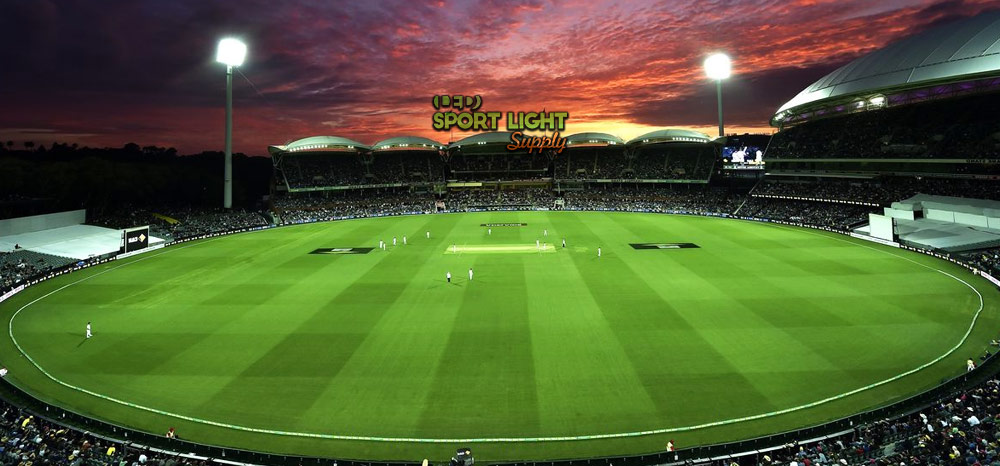
Usually, the cricket ground extends for many meters (up to 150 m). The lighting design must provide enough brightness for everyone. Both for the players and umpires on the cricket field anyway. So, high power lighting fixtures are needed to illuminate the whole pitch.
400W, 1000W, and 2000W are the common wattage outputs of most LED cricket stadium fittings. LED is the acronym for Light Emitting Diode (light-emitting diode). It is nothing more than an optoelectronic device. In short, it exploits the optical properties of specific semiconductor materials. LEDs convert the electrical energy that passes through them into visible light. And it does so efficiently, with minimal heat dispersion (about 10%). And safely, by providing completely Ultra-red- and ultraviolet-free light.
2. High mast light poles
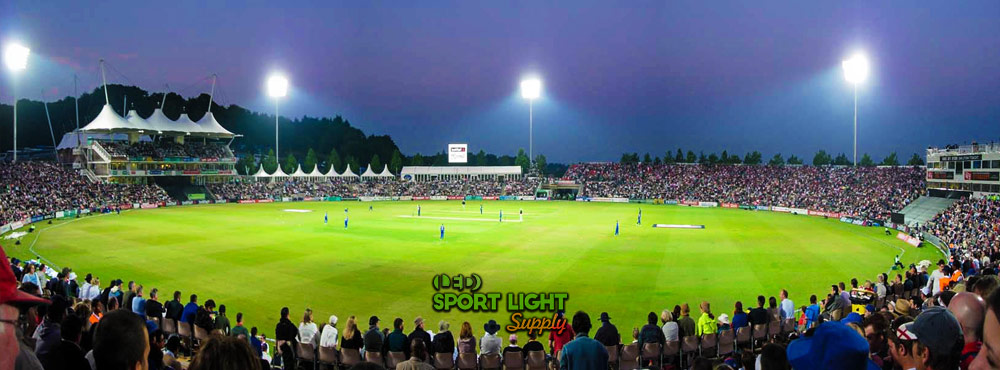
Light poles are the very essence of any outdoor stadium. So, virtually every lighting standard ever written refers to them at some point. Generally speaking, high masts are 14 to 40 meters tall. You find them in precise places just outside the cricket ground. But in reality, the lighting designer generates a lighting layout to decide where and how many poles to install.
The height of every single light pole depends on many factors. For example, the overall cricket field dimensions. Or the level of competition. In fact, for international and first-class competitions, broadcasters need the best lighting conditions.
3. Lighting control system
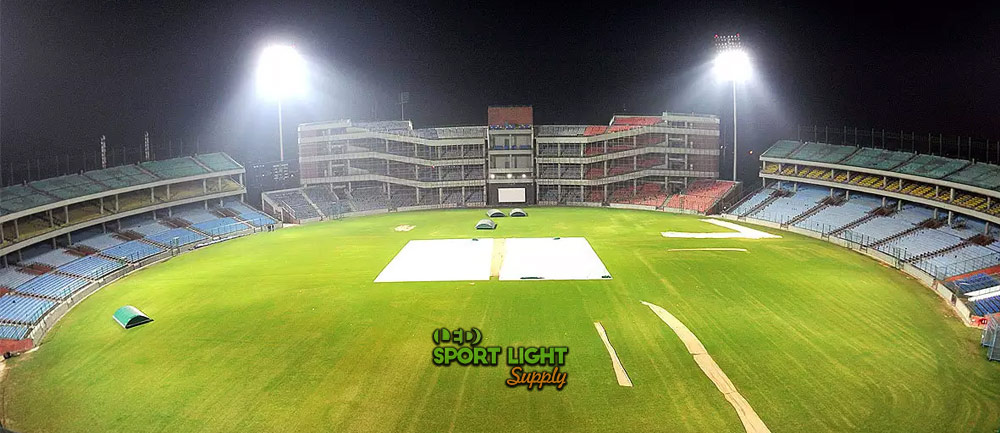
Today, the control booth is not the only place where you can control the lights in the cricket stadium. You can control them remotely via an app or Bluetooth connection. In most cases, you find a DMX or DALI controller with its own interface.
The operating mode (DALI or DMX) changes with the type of light fixtures. In detail, DMX is a protocol that allows you, through a single 3pin cable, to send a numerical value from 0 to 255 (DMX value) to 512 channels (DMX channels). Similarly, DALI lets you interface with up to 64 channels. Custom or more advanced lighting systems can even use a control module for DALI and/or DMX lights for simultaneous use. In the latter case, two connection lines are managed in parallel.
4. User interface
The user can control the brightness of the cricket stadium lights via a physical panel, computer, or smartphone. Usually, specific software allows you to adjust the intensity, color, and special effects. But universal software is also available for some lighting systems.
The lamps can connect directly to a WiFi router. Then, the user can turn every single fixture on and off. In this case, a password protects the cricket field lighting system against intruders.
Most user interfaces let you schedule a lighting program or create a profile. For example, you can create custom settings for the cricket club activities that activates every Tuesday.
5. Pole and underground cabling
With all the spectators outside and fielders inside the cricket ground, you need to make sure the light poles and cabling are secure. The electrical wiring goes inside the high masts and exits underground to connect to the grid and the controller.
The lighting layout must consider each track that signals each access area. At the same time, the high mast lighting must converge at the right part of the cricket field. So, the underground cabling must consider both the position and the maintenance repairs as well.
If the previous cabling system is outdated and not upgradable, temporary lighting solutions might be an option. At least, while you wait for the right time to renovate the cricket stadium.
6. Lightning protection system
Outdoor cricket stadiums are at the mercy of lightning strikes. So, it is critical to install a lightning rod or conductor on top of your light poles.
Each country has its own lightning protection requirement. Here is a short list of the standards you find in several continents and countries:
- AS/NZS 1768:2007 for Australia and New Zealand
- BS EN 62305-3:2011 for Europe
- SANS 10313:2012 for South Africa
- IS 2309 (1989) for India
- NFPA 780 for the United States of America
A lightning protection system ensures the safety of the players, umpires, and spectators. As well as protecting all the LED lights that you installed.
7. Power supply
From power plants, a cricket stadium gets the electricity produced by the conversion of raw materials. But once the production of electricity is finished, things can get messy. Its transport and distribution can create complications. Especially in remote areas. That is the main reason why the typical cricket stadium stands in an urban district. Here, or in residential areas, power supply issues are rare.
Reinforced insulation plays a vital role in the protection against electric shocks. Then again, the power supply must provide enough power to light up the LED luminaires. And hybrid or alternative power supply sources are available as well. For example, solar panels and batteries, or generators.
Outdoor cricket stadium lighting layout
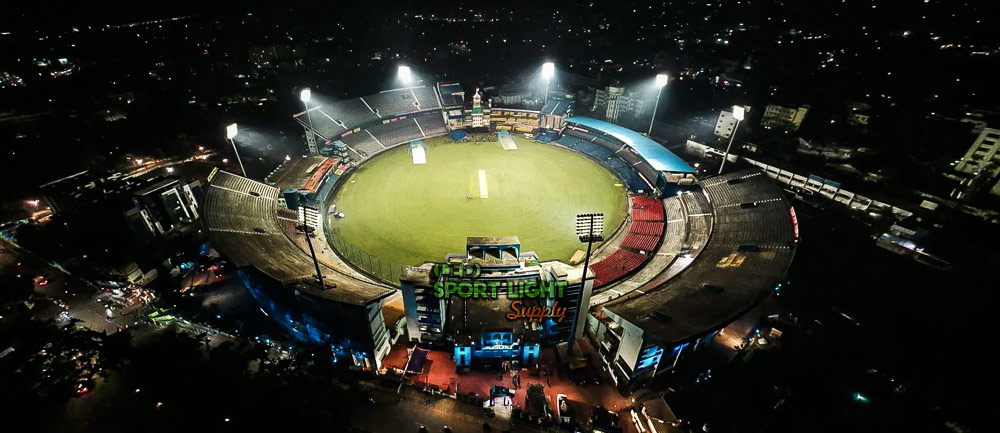
In essence, the lighting layout follows the principle of efficiency. The lighting designer studies and analyzes the design of the cricket field to find the best compromise between luminous intensity and total power consumption.
Experts like us gather several data first. Then, we put the data into software to find out the best determining factors. The main goal of the lighting layout is to define the appropriate:
- Number of cricket ground light poles
- Light pole positioning in the cricket stadium
- Height of high masts
The lighting apparatus must evenly light up everything. From the bowler hitting the deck to the extra cover in mid-off. And the lighting layout helps you to achieve that.
1. Number of cricket ground light poles
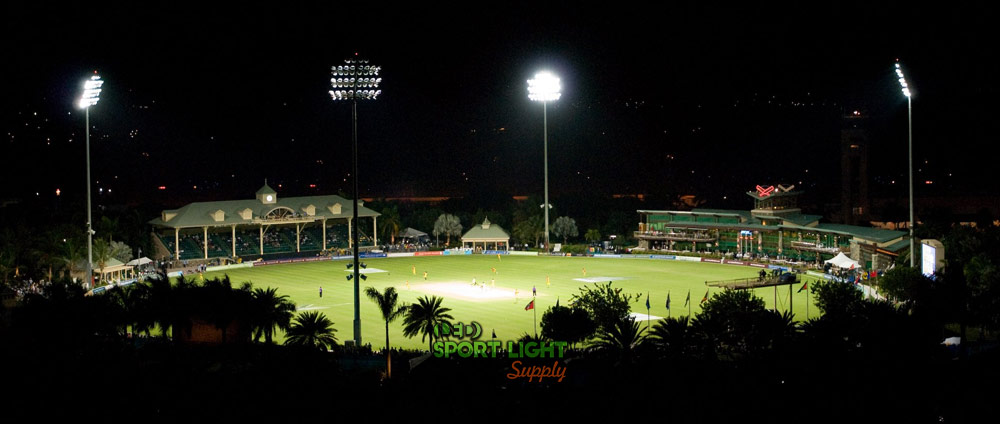
When deciding the number of light poles in the cricket stadium, the level of play matters. In fact, more light poles are recommendable for televised matches. The 4- and 6-pole designs are the two most widespread choices.
With just two more light poles, the cricket field can receive better lighting. As a result, the players’ shadows become really soft or non-existent. Broadcasters also need high-quality LED flood lights for creating flawless and realistic videos. Besides, more masts mean that you can control light pollution better. A 4-pole design requires you to use a broad beam angle to comply with the lighting standard, after all.
2. Position of the light pole in the cricket stadium
One of the main concerns of proper high mast positioning is glare. Above all, the location of each light pole should follow the aiming philosophy of the lighting standard. For reference, take a look at the AS/NZS 4282:2019. It explains each requirement for preventing outdoor lighting obtrusive effects. You might find other standards that apply to your location. Many documents address a series of issues, such as:
- light pollution
- glare control
- safety precautions
The most suitable layout for your cricket stadium may differ from other facilities. But usually, a 5 meters clearance zone runs from the boundary line to the high mast position. Alternatively, a fence might provide basic protection.
If you find it hard to find any cricket lighting standard, try searching for other sports lighting standards. Sometimes, a committee might create a uniform document for several sports.
3. Height of light pole
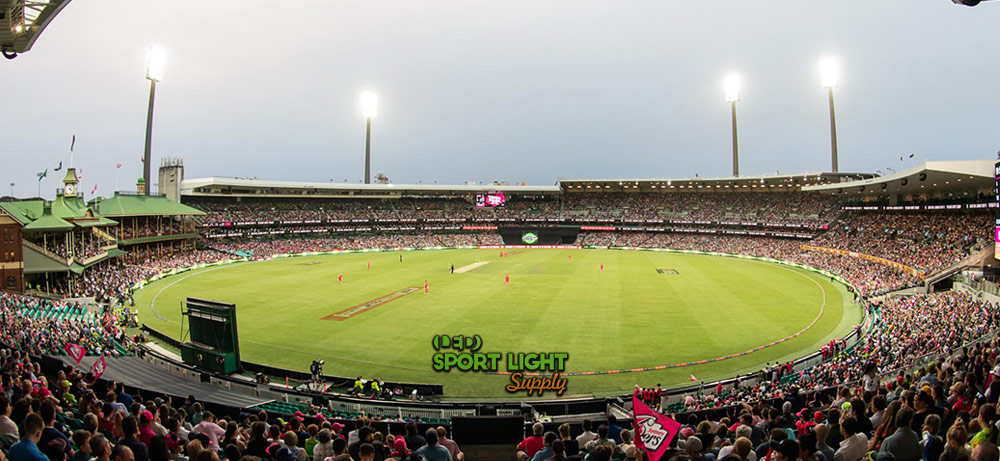
Depending on the level of competition, you can expect to get 14 to 40m tall poles. The height of the light poles is directly related to a comfortable vision. With the right vertical angle, no LED light will blind any bowler or batsman. Plus, the higher the light pole, the better light distribution on the cricket field.
You can also calculate the high mast height by multiplying the distance of the pole from the cricket ground center by 0.36. But beware, this formula only applies to local or non-professional cricket activities. Basically, any non-televised competition or event.
For the best results, use light poles high at least 26 meters or more. For first-class and international competitions, use higher poles. The goal should be to achieve a 25-degree angle from the lowest pole to the oval center.
The indoor cricket ground and practice net lighting layout
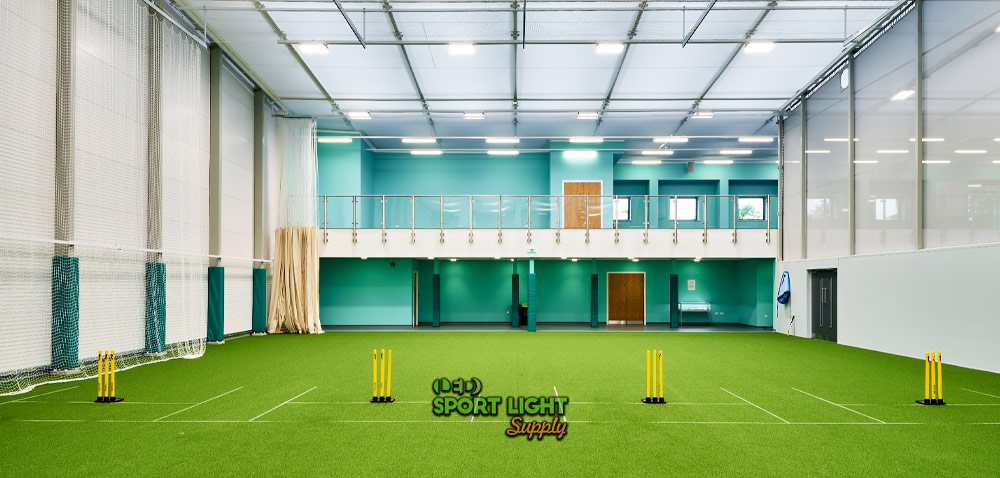
As you can imagine, the lighting standard for indoor cricket facilities sets new rules. For one thing, the size and dimension of the indoor cricket stadium pose construction limits. The place might contain a multi-sport pitch for cricket and other activities. Then again, a distinct requirement regulates the practice net lighting. For example, you need to decide between direct and indirect lighting solutions.
Unlike outdoor light sources, you use a specific LED product indoor. These fittings limit the space between the cricket ground and the ceiling. This also means that you need to consider the distance between the lighting bodies and the practice net wall. Finally, you need to adjust the number of light fixtures to the size of the cricket net.
1. Ceiling height
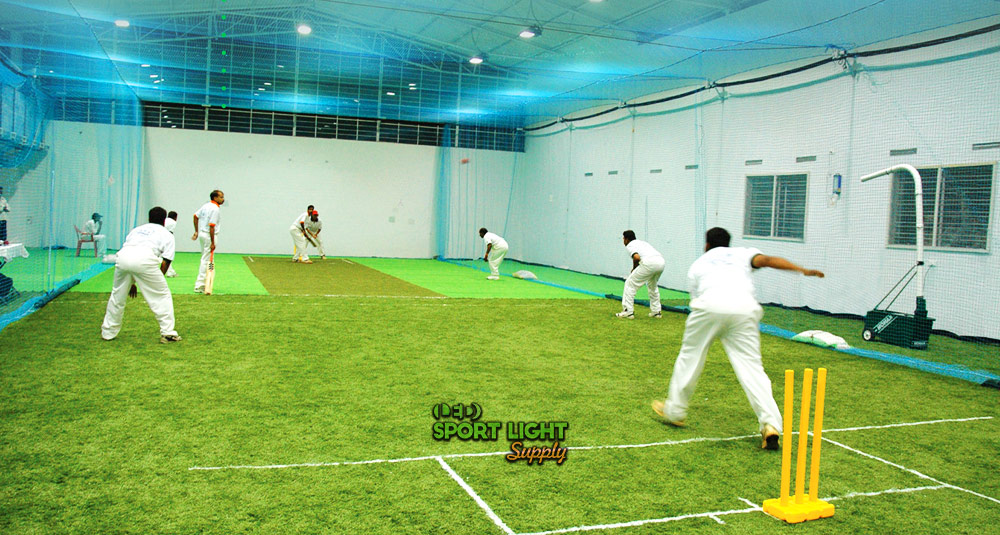
The recommended ceiling height is between 4 and 4,5 meters. In detail, this space permits batsmen to hit a lolly or a shooter.
A minimum height is necessary so that the batsman will not have to restrain the backlift. At the same time, the indoor cricket field is ideal for improving players’ footwork and form. For these reasons, the ceiling height should not be shorter than 4 meters. Otherwise, the ball might hit the ceiling too fast even for those with a keen eye. If there is too little space, it is harder for the coach to correct the players’ mistakes.
2. Direct or indirect lighting for an indoor cricket practice net
A critical step is deciding the type of lighting to use before you install the lights. You can choose between direct or indirect lighting. Here are the main differences.
Direct:
- You point the lights downward
- The fixtures light the cricket ground directly (higher contrasts)
- It is easier to cause glare
Indirect:
- You point the lights upward, then use the reflected lights to light the cricket ground
- The lighting uniformity of the indirect approach is higher, but you need extra lights and running costs. Mostly because there is around 10% to 30% light loss, depending on the material of the ceiling.
- It can create a more sophisticated ambience and design.
3. Distance between the indoor cricket ground and the ceiling high bay lights
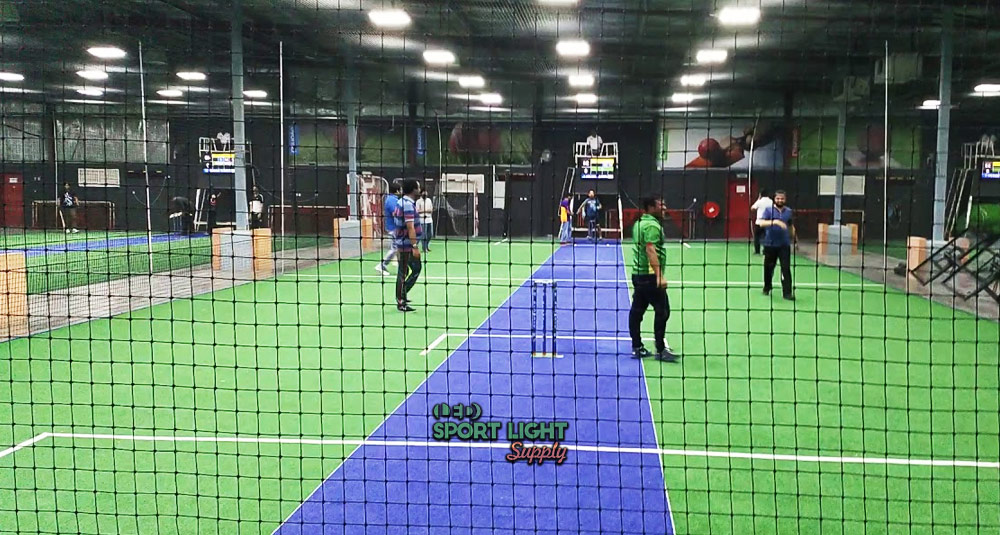
In most cases, you need 1,5 to 3 meters (5 to 10 ft), depending on the beam angle and ceiling height.
More precisely, you need 1 light per 30 x 30 sq. meter area, but it still depends on the ceiling height and beam angle of the flood lights. So, the type of lighting you choose will make a difference in this department.
High bay lights are the most widespread light fixtures for indoor sports facilities. Usually, they provide direct lighting. Also, you need to hang them on frames or sockets and wire them up accordingly.
4. Distance between the lighting fixture and practice net wall
The drawback of practice nets is that they can create shadows. So, the coach or cricket stadium designer puts them near a wall. You should want to keep at least 1,5 m (5 ft) to avoid shadow on the artificial turf or part of the cricket ground.
This standard applies to any cricket netting arrangement as well. In detail, it does not matter if you have more tunnel-like sections or a separate cricket pitch for practice. The distance between the lighting fixture and practice nets ensures optimal visibility due to the nature of the netting thickness.
5. Indoor cricket net size
The number of lights needed increases with field size. In general, you still need 1 light every 30 x 30 sq. meter area. Nonetheless, the beam angle will become more relevant as you pick the cricket training net design.
Above all, the lighting layout should take into account the standard size of cricket nets. Usually, they come in three sizes:
- 3.60 m
- 3 m
- 2.70 m
Depending on the ceiling height and thickness of the practice net, you might need to use more LED lights. Both in order to satisfy the lighting requirement and to have an evenly spread illumination.
Cricket stadium lighting design and standard
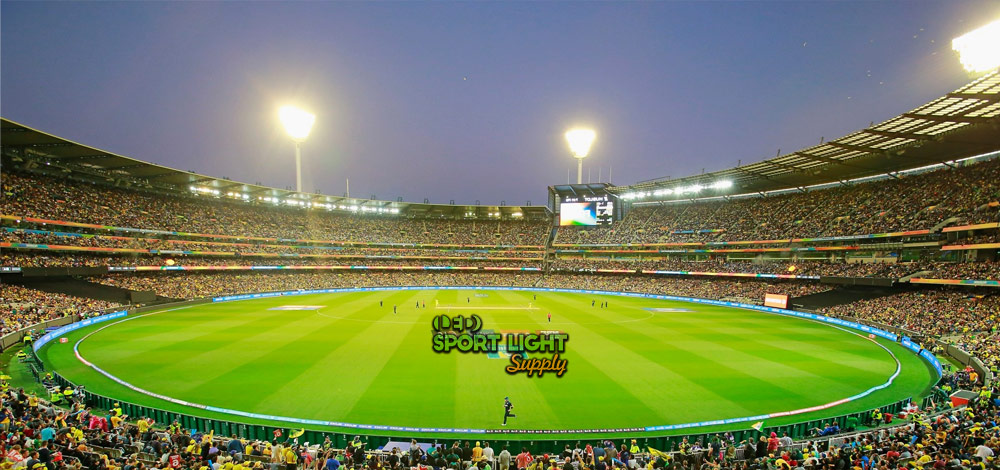
In order to buy the most cost-competitive light sources, you must know what they will be useful for. Understanding the cricket stadium lighting design and standard is imperative. Plus, a smart lighting design can help reduce the running costs.
For one thing, learning what a lux level is useful. It will give you an idea of the difference between varying levels of competition. Grasping the concept of lighting uniformity removes any misconception about luminous intensity.
Setting a precise color temperature might influence the bowler’s or fielders’ performance. Before receiving broadcasters, you should figure out the difference between CRI and TLCI. For televised events, you need to replace your lights with flicker-free LED products. Finally, glare and light pollution are also crucial factors. They are common topics in any cricket association’s requirement.
1. Lux (footcandle) lighting requirement for cricket stadium
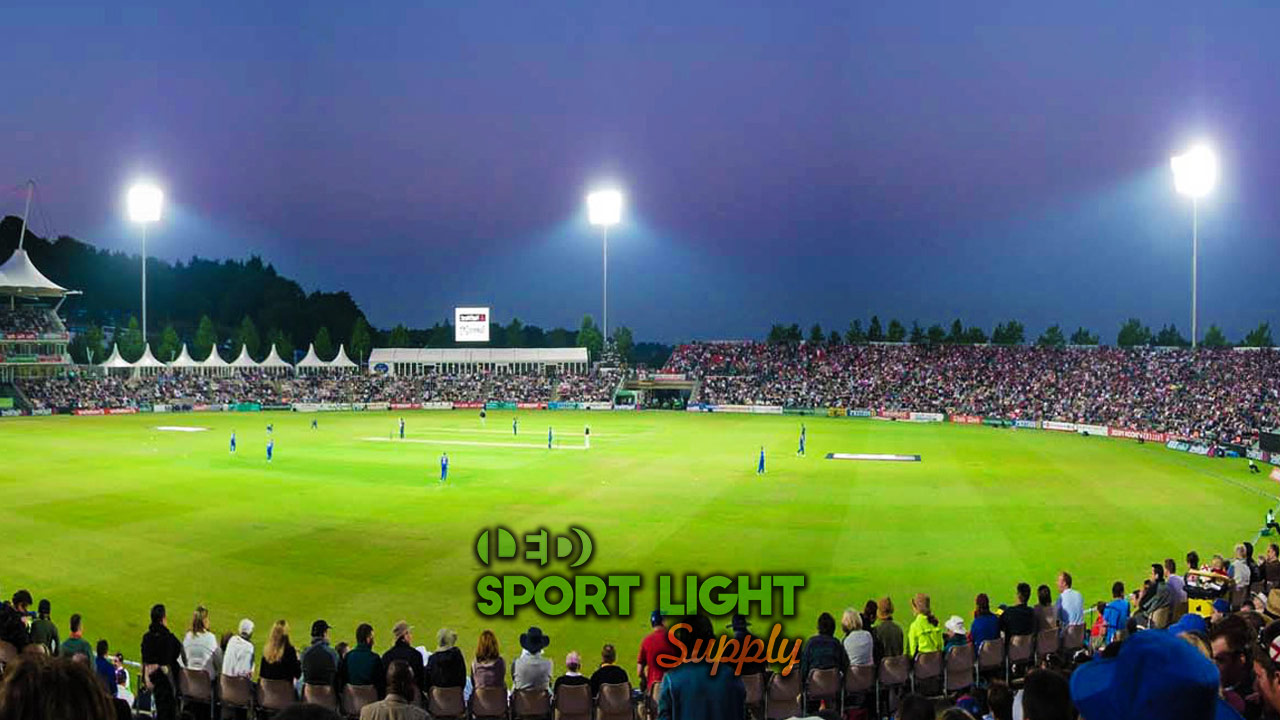
Illuminance is an objective quantity. To be precise, it is independent of the position of the surface with respect to the observer. Lux is nothing more than the standard SI unit of measurement for illuminance. In detail, lux measures the amount of light flux intercepted by a surface. Americans use footcandle (fc) as a unit of measurement. Keep in mind that 1 footcandle = 10.76 lux.
Some people mistake illuminance for luminance. Instead, luminance is a subjective quantity, dependent on the position of the observer. It corresponds to the amount of light that actually reaches our eye. In other words, luminance is about light that travels in a precise direction. Remember that the standard SI unit for luminance is the candela per square meter. Please, do not confuse the latter with the American footcandle unit.
In this section, I am going to refer solely to illuminance levels. To be precise, the necessary lux levels for the infield and outfield parts of the cricket field. If you want to find out the footcandle equivalent, you can always multiply the lux level value by 10.76. Or keep reading below. You will find the correspondent footcandle value of the following standards.
Here are the lighting standards for a cricket stadium, divided by the level of competition:
- Class I – 750 lux (infield), 500 lux (outfield)
- Class II – 500 lux (infield), 300 lux (outfield)
- Class III – 300 lux (infield), 200 lux (outfield)
- Match practice – 200 lux Non-body contact training – 100 lux
- International tournament and 4K broadcasting – 1500 to 2000 lux
Before you host official matches, tests are mandatory. Venue operators and local councils will verify the lighting conditions. Planning, design, and layout of the lighting system must ensure quick player reactions to safety hazards. For these reasons, professional cricket lighting designers like us must be precise. So, we use the latest software to create the most performing solutions.
In some areas, the lighting codes for other sports might be similar. Or they could be the same for the most part. For example, the Australian first cricket lighting class resembles professional football. And also the baseball, hockey, and softball requirement. The 5.380 footcandles necessary (500 lux) are still for the outfield, though. The square lighting standard (8.070 fc or 750 lux) is always higher. And this detail is linked to cricket, baseball, and softball activities at all levels.
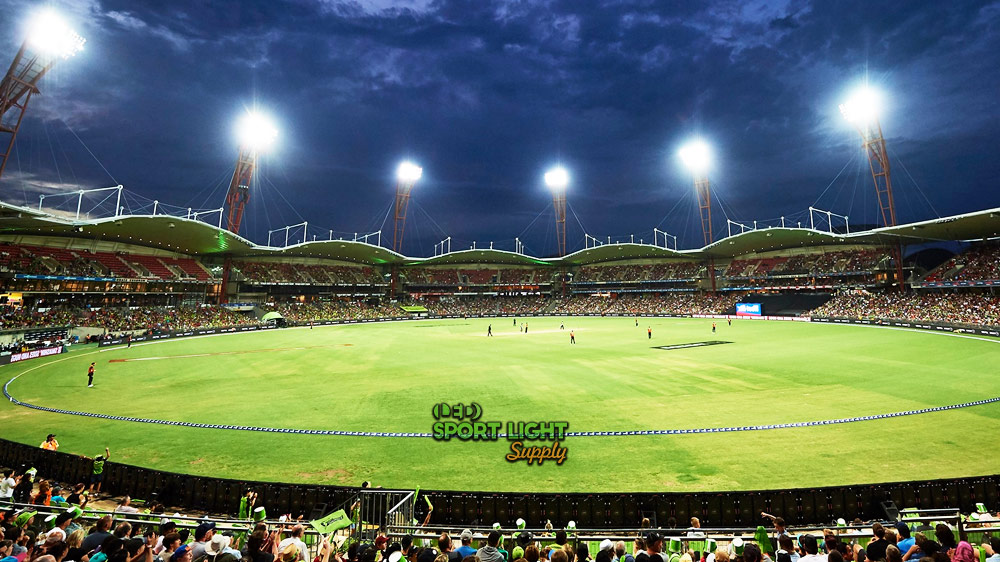
Class I includes top national cricket stadiums and professional club facilities. Then again, class II shows lower lux values (5.380 and 3.228 fc, respectively). Mostly because the cricket ground welcomes national club competitions only. These two classes still deal with non-televised matches. Even though the first class applies to International matches.
By contrast, the International tournament class standard deals with televised events. In fact, 4K broadcasting is now a reality and requires the most efficient lighting conditions. 1500 lux equals 16,140 footcandles. But the lighting standard should rise to 2000 lux (21,520 fc) for the infield.
Of course, the lighting layout changes drastically with the varying scenario. But sometimes, retrofitting or upgrading a cricket stadium does not mean that you need to add more high masts.
A professional lux assessment could indicate that adding more intense light sources can be enough. Lux testing also must take into account the maintenance factor. That is, how the light efficiency of the lighting structures changes over time.
With constant use and aging, the LED apparatus might lose brightness. In this case, the lux level can drop significantly. That is why the lighting standard for the cricket field comes in the form of a range.
Any cricket stadium owner should perform regular tests to ensure optimal lux levels. Especially at high levels of competition. That is, Class I, II, and International tournaments.
Class III and Match practice are different because of safety conditions. To specify, Class III refers to local club matches. As well as recreational activities. 3.228 to 2.152 fc (300 to 200 lux) of bright light is more than enough for most local cricket competitions and events. More importantly, cricket clubs should use white balls. Plus, protective equipment to further reduce the risk of injuries.
Mainly, match practice refers to non-body contact training. This means that the 2.152 and 1076 fc (200 and 100 lux) values provide a less intense glow. However, batsmen can set a bowling machine to train with full pitches, yorkers, and short-pitched balls. Bowlers can still perform full tosses or long hops.
Professionals like us use a lux meter to perform high-precision light measurements, both indoors and outdoors. But mostly, we make sure that the lux level is in line with the design objectives.
The cricket ground lighting layout must consider the spectator viewing requirement. In other words, luminance is still relevant. But it will not be an issue if the proper lux level is in place.
The lux meter can be used for reliable measurements of light intensity or as an auxiliary accessory in various fields. Especially in a new cricket stadium construction for the calculation of natural light exposure. Through an integrated spectral filter, it is possible to filter the infrared components. In this way, it is also possible to detect only the spectrum of light that interests you. For example, to calibrate light effect machines.
It should be noted that some sports venues may host competitions in an improvised cricket field. In that case, the level of play should suggest which lighting standard to apply. Sensitive locations may also require higher values to protect the historical value of the place or its surroundings.
The outdoor sports lighting system should illuminate the cricket field at all times. To put it another way, the appropriate lux level should be maintained when it gets dark. So, cricket stadium owners should light the LED fixtures before sunset.
Within the scope of the lighting standard, the correct level of brightness can be energy efficient. LED lights give you a high-tech lighting solution to achieve the desired lux level while reducing the carbon footprint. As well as consuming less energy.
2. Lighting uniformity standard of cricket field lights
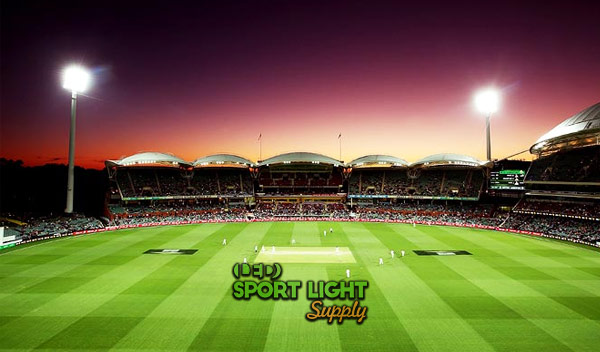 On the cricket ground, no player should find bright and dark areas. Instead, lighting must be evenly spread across the cricket field. This is what uniformity of illumination is all about.
On the cricket ground, no player should find bright and dark areas. Instead, lighting must be evenly spread across the cricket field. This is what uniformity of illumination is all about.
The floodlighting design and layout must distribute light equally in every area. Of course, adjustments might be necessary from time to time. But the standard indicates two precise data. The first is the lighting uniformity. In other words, the ratio between the minimum and the average value of illuminance (U1). And the ratio between the minimum and maximum value of illuminance (U2) gathered across the cricket field by sampling. By using U1 and U2, you can achieve higher uniformity.
The second factor is the maximum uniformity gradient. According to the standard, the latter value is the same for each lighting class. In detail, it must be less than or equal to 20% per 5 meters. To specify, the maximum uniformity gradient requires that no reading in any adjacent zone is 20% more bright than the one being sampled. Sampling refers to the use of a measuring grid for the lighting assessment of the cricket ground.
Here is the uniformity requirement per lighting class:
- Class I: U1 = 0.7. U2=05 (infield). U1 = 05. U2 = 0.4 (outfield).
- Class II: U1 = 0.7. U2=05 (infield). U1 = 05. U2 = 0.4 (outfield).
- Class III: U1 = 0.5. U2=05 (infield). U1 = 03. U2 = 0.3 (outfield).
In an indoor cricket stadium, a U1 of 0.7-0.8 is recommended at all levels.
3. Color temperature
Professional batters and bowlers are accustomed to a color temperature of more than 5000K. Color temperature is a term used in the field of lighting to quantify the hue of light. According to the international system, the reference unit of measurement is the Kelvin.
As far as I know, no cricket field lighting standard imposes the use of a particular color temperature. However, a color temperature between 5000 K and 6000 K is probably best. Mostly because it resembles natural daylight.
4. CRI & TLCI
These two acronyms are quite relevant for the overall lighting quality yet often forgotten. CRI stands for Color Rendering index. Simply put, it is a numerical value that indicates how colors appear to the human eye. Not every light source reveals the chromatic tones and hues of illuminated objects in the most realistic way possible. So, a high CRI value on a scale of 100 tells you that the light produces high-quality lightwaves.
Well then, CRI is for eyes, TLCI is for the camera. The latest LED light labels and data sheets display the Television Lighting Consistency Index. The higher the value on a scale of 100, the better the colors picked up by a professional video camera. As you can guess, a high TLCI value is necessary for sports venues with the broadcasting of live cricket events.
In any case, you need a CRI or TLCI ≥ 65.
5. Flicker-free lighting
Only flicker-free lights let you record or stream a cricket match without any flickering. With the diffusion of LED lighting systems, flickering became an issue. Broadcasters and fans could not capture a game without getting visual streaks, strobing, or flickering in their videos.
Today, flicker-free LED lights have become widespread. But in an older cricket stadium, some LED lights might need to be replaced with flicker-free ones.
6. Glare
A glare restriction limits the GR rating to be <50. Mainly, reducing glare consists of ensuring horizontal visibility. You can point the mounted light fixtures downward for an outdoor cricket field. But for indoor cricket facilities, installing some type of shielding might be unavoidable.
An unobstructed observer’s line of sight is not always enough at close quarters. So, the glare rating values help you maintain the GR standard. Plus, they ensure the safety conditions of play areas.
7. Light pollution (light spill)
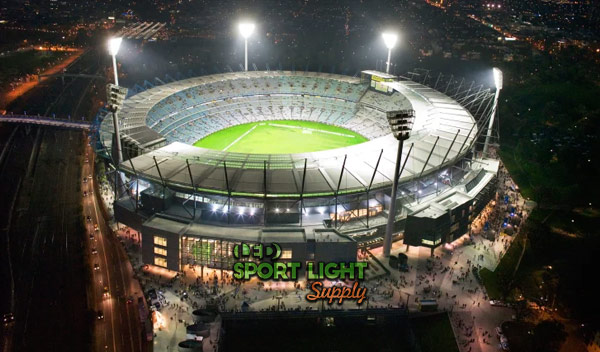 The lights should avoid light spill because they could create problems for nearby residential areas. Luckily, you can reduce light pollution by reducing the pole height and using smaller beam angle lighting fixtures.
The lights should avoid light spill because they could create problems for nearby residential areas. Luckily, you can reduce light pollution by reducing the pole height and using smaller beam angle lighting fixtures.
Spill light can become obtrusive and affect others’ behavior. Besides, it is also physiologically problematic for animals. In fact, light pollution can disrupt any living creature’s sleep-wake circadian cycle. But above all, you should fix any light spill to avoid disputes involving the neighbors and bystanders.
Special consideration of buying cricket stadium lighting system in India
1. Waterproof lighting fixtures for Indian cricket stadium
India is renowned for its tropical wet. In detail, the climate of India can be quite challenging. Due to the warm weather, rain is more likely to fall many times per month onto the cricket field. So, waterproof protection is necessary.
Waterproof LED lighting fixtures for cricket facilities have ingress protection. Plus, they work underwater. In detail, the spec you need to look for is the IP rating. For the typical Indian cricket stadium, IP68 LED flood lights are recommendable.
2. Lightning protection
Where there is a storm, lightning strikes are bound to be frequent as well. And India can face more than eight cyclonic storms per year. So, prepare for stormy and rainy weather by installing a suitable lightning rod.
Lightning protection can save lives and LED fixtures. Remember to keep up-to-date with the latest standard and employ useful new tech and systems. For more info about the latest standard, contact your local government agency on energy and the environment.
Total protection might not always be possible. But in India, you should try to prevent the damaging effects of lightning from the start. Be sure to plan the lighting design and layout accordingly.
3. Get a good heat dissipation system
On the flip side of the coin, India has hot weather. In detail, the pre-monsoon season is the hottest, with temperatures above 35°C (95°F).
The cricket field lights should have a good heat dissipation system to transmit the heat away from the lamp body to the surrounding space.
LED lights are maybe the only viable choice for this extreme weather. So, check or request the most performing dissipation system for your cricket stadium lights. Usually, LED products come with a pre-built heatsink. But ask for custom solutions if the cricket ground is in a very warm place.
4. Low Consumer Price Index
Price changes can make your life easier. Since buying LED lights might cost you slightly more than other light sources, monitoring the prices is a savvy move. Moreover, a low CPI leaves you more budget to spend on better spectator experiences.
The cricket stadium lights should be inexpensive. And they should last very long. At least for more than 150,000 hours.
Keep an eye on the Indian government’s economic policy as well for more informed decisions.
Advantages of LED replacement of metal halide, halogen, mercury, or HPS cricket field lighting
1. Energy saving
LED sports lights have a significant economic advantage. Mainly because they develop a flow of light 5 times more intense with the same absorbed power. Closely related to this fact, only a minimal part of the absorbed energy is transformed into heat. In other words, LED lamps remain relatively cold even after several hours of operation.
Since LEDs require a minimum of energy absorption for their operation, you can power them also with energy from alternative sources. In fact, solar models let you use daylight to light up independent lighting systems. This means that you can save in two ways. On the one hand, you can choose a LED flood light with equivalent lumen output and lower wattage. On the other, you can install solar panels or buy solar models.
2. Long-lasting
LED lights have an average life span of 100,000 hours. But, the most professional cricket stadium LED lights can offer more than that.
Here is a short list for comparison with the other types of lamps:
- Halogen bulbs last up to 2,000 – 4,000 hours
- Mercury vapor bulbs average 20,000 hours in total
- HPS lamps also last up to 20,000 hours but manufacturers themselves suggest you change them every 5,000 hours
- Metal halide lamps last up to 30,000 hours at best
3. Better lighting uniformity
The diodes that make up the LED lamp ensure a more controlled light emission. High-efficiency chips of new conception are constantly released on the market. Thanks to the use of new and increasingly sophisticated technologies, LED products can satisfy every lighting standard. For example, SMDs and COBs models are two types of LED chips. You can install both of them in any cricket stadium lighting design to achieve the best uniformity and no shadows on the cricket field.
4. Better CRI
Thanks to its high color rendering capacity, LED is now the leading tech among the various light sources.
The CRI parameter goes from 0 to 100 Ra, where 100 corresponds to the maximum possible color fidelity.
Most LED lights have a color rendering index higher than 90, therefore excellent.
Professional cricket ground LED lights can reach up to 95 Ra, which is more than enough for any requirement. But at the same time, it makes the cricket game more exciting and pleasant to watch. The spectators will savor every paddle scoop or half-volley better than ever.
5. Smart lighting control
LED lights are just more convenient and user-friendly. Thanks to smart stadium lighting control options, you can control the brightness and switch on/off the lights from your computer or smartphone.
An intuitive interface lets you dim the dimmable lights or create special effects. What is even better, you can control the lights and other metrics from the same station or position without having to move to each panel.
How to buy the best cricket ground and stadium lights?
1. Lighting efficiency
Good LED products should have >150 lumens per watt. In fact, such a ratio reveals the manufacturing quality of the LED chip.
There are many brands and models of the same LED chip on the market. Depending on the quality, more or less power can be supplied.
Broadly speaking, the larger the chip, the better the performance. Different sizes of the chip can lead to LED of a certain size and aesthetics.
Usually, smaller chips generate more heat and, consequently, a lower flux of light. Larger chips, on the other hand, have a higher dissipation capacity, which results in better brightness and even longer duration.
2. Beam angle
A large beam angle is best suited for short-range use. On the other hand, a small beam angle is ideal for long-range distances.
For starters, spotlights should never blind the batsmen, fielders, or the bowlers. But they can be useful to provide extra brightness for illuminating the wicket. In this way, the main umpire can give precise calls every time and speed up the match.
A wide swath of light is better for the ads on the cricket field. With this in mind, the lighting design is one of the many things that sponsors consider when evaluating international cricket grounds.
3. Life span
Choosing a product with a long life span is critical when buying stadium lights. As previously mentioned, LED lights offer 150,000 hours of operation or more.
Investing in durable LED lights brings you another positive effect. That is, less maintenance. Cricket stadium LED lights are built to last under several adverse conditions. So, you can expect to install reliable luminaries that will not need many repairs over the next years or during their entire life cycle.
4. Anti-glare lens
Traditional floodlights have cup lenses that amplify the luminous flux. But at the same time, they can cause glare.
The latest LED light models have an anti-glare lens. In short, a directional design allows for the illumination of a broad or narrow area with great precision. As a result, the beam angle is less likely to hit the players’ eyes during the match.
You should watch out for filters, shielding, and other accessories as well to further reduce glare. Ask the reseller if these accessories are sold separately because they often are.
Portable cricket field lights or permanent light poles?
Before you place an order for your brand-new cricket stadium lights, consider this. Would you benefit in any way from temporary lighting solutions such as portable cricket field lights?
Permanent light poles might cause construction delays. Especially if you need to renovate the old lighting design or create a new layout. Sometimes, buying portable cricket stadium lights can be better than permanent light poles.
Movable light towers can provide emergency lighting. Moreover, you could recover a big chunk of your budget and invest it somewhere else.
1. Solar panel compatible
Make sure the new lighting design is solar panel compatible. Even if you do not plan to invest in solar energy yet.
New research and development in renewable energies might prove to be cost-saving in the long-run.
Today, getting a solar panel could be expensive. But soon, you might implement this tech at a lower cost.
You can also opt for smaller solar panels to recharge the batteries of portable light towers. Or place some solar lights outside the cricket stadium and even in the parking lot.
2. Installation difficulty
Installing and replacing LED lights is pretty straightforward. But if you need to renovate or retrofit the cricket stadium lighting layout, you might need professional help.
Converting the old traditional types of lamp holders and circuits for more efficient LED lights can be tricky. Even dangerous.
Usually, the installation difficulty depends on the previous light model. If you are creating new cricket ground lights, I advise choosing LED lights. Mostly because you will not have any problems with accidental replacements. Even if you are not going to buy the cricket field LED lights from the same reseller every time.
3. Warranty
The longer the warranty period, the better. As you can imagine, high-quality products are guaranteed for many years to come.
Beware of cheap products with only one or two years of warranty because they might break down. For example, such LED lights could have a low maintenance factor. That is, how fast the luminous efficiency of the LED chips drops to a constant low emission. If that is the case, you will have to buy more lights and new light fixtures sooner.
The cricket stadium lighting design must take into account the quality of the luminaries to avoid premature deprecation. In other words, you might not be able to stop the decline of the LED lamp brightness, but you should pick products with the best warranty in case a deterioration happens.
How to reduce cricket stadium light cost?
1. Getting a good lighting design
No matter how you look at it, getting a professional lighting design and layout matters. Here are some of the obvious benefits:
- Optimization of the use of LED flood lights
- Cost-effectiveness (you avoid using too many unnecessary lights, wrong wattages, etc.)
- Improved layout by using DIALux to generate a photometric analysis of cricket stadium lighting.
Experts like us have all the tools and experience to offer what clients want. Moreover, you get the professional advice of specialists that know this industry inside out.
2. Using the same types of lighting fixtures in the cricket field
By choosing to use the same lighting fixtures in the cricket field, you can reduce the installation costs. A typical example is getting lights with the same power, same lumen, same beam angle, same color temperature.
Just from a practical point of view, it is easier for the electricians to install the lights. But not only that:
- you will encounter fewer problems if you need to update the lighting system
- exchanging lights can be an alternative while you wait for the replacement of the defective ones
- stocking a few spare cricket field floodlights will take care of most temporary issues
3. Reduce the light pole height
The main benefit is the reduction of light loss. However, lighting uniformity may be reduced slightly.
Sometimes, it can lead to injuries. If the twelfth man appears consistently sooner than expected, revert back to the previous light pole height. Do some testing. Eventually, you will find a lower mounting height of the cricket field lights without compromising the players’ safety.
4. Using more poles
You can reduce light loss by installing more high masts around the cricket ground. In this way, each light pole will be responsible for a smaller part of the cricket field. As a result, the overall illuminance will be maintained more easily.
Often, just two more poles will do. A 6-pole lighting layout can let you reduce the running costs. But at the same time, light planners need precise calculations and information to achieve the best results.
How to select the best cricket stadium lighting companies and suppliers?
1. Expertise and experience
When building a cricket stadium, the owner often relies on a single company to do the work. So, some companies specialize in new projects. On the other hand, other companies have more experience with repairs and retrofitting.
Each company has an area of expertise. While every company can do the same job, more or less, the same way, you might benefit from knowing what they did in the past. Ask for recent projects the company has made and delivered. Then, visit the site to evaluate the company’s experience and reliability with cricket field lighting.
2. Price
If you ask for a free quote from different companies, you will notice one thing about the price.
The price should not be the lowest or highest. In fact, the lowest rate for this type of work means the company is selling shoddy products. Other problems may include low-cost materials, obsolete LED lights, and underpaid and unprofessional manual labor.
If the price is too high, the company may not be doing so well. After all, there are not that many cricket stadiums per city. A single company should be able to provide services for every cricket stadium that requires their expertise at any given time. So, higher prices often mean the company is not working consistently more than it is too busy with too many orders and requests. Then again, inquire the staff for more details about their latest projects.
3. Free lighting design and customization
No free quote is reliable without a proper DIALux photometric simulation report. When a reputable company makes a proposal, the free quote should be transparent and detailed.
For example, our company takes a multi-step approach. We like to present our clients with the most suitable lighting design solution. But we do not discard any viable option or idea just for the sake of a lower price. Our primary goal is to understand the client’s vision to help him or her get the desired result. So, you provide custom cricket stadium lighting design and layout as well.
4. R & D
Knowing the company’s past is imperative. But at the same time, you should find out what their R & D department is doing.
Each professional lighting company should have a Research and Development department. Only in this way the cricket stadium lighting company can regularly improve the quality of their sports lighting products.
Without R & D, the company is just a reseller agent for some manufacturer. Basically, they are after your money and the quickest deal.
5. Customer service
Response time and quality of service depend heavily on the customer service’s ability to keep the client happy.
By happy, I mean totally content during each phase of the project. In fact, all sorts of doubt and questions might arise from the planning phase to the actual delivery day. This is normal, and it is the customer service’s job to guide each client and provide information.
If the customer service is too slow, the company does not honor the potential client’s interest. In other words, it is a lack of respect. Similarly, not being able to reply to each question is a bad sign. Of course, a customer service staff member does not have to be a know-it-all and provide each answer on the spot. But taking care of listening to the client’s questions and give an estimate of when an explanation will be available makes all the difference between bad and great customer service.
Cricket stadium lighting questions and answers
1. How many watts and lumens are cricket stadium lights?
Without a lighting design and layout, it is hard to give a precise answer. So, here is a wattage and lumen range to give you an idea of what you might need.
Individual lights should range between 400W and 2,000W, which roughly equals 60,000 to 300,000 lumens.
The whole cricket stadium needs 50,000W to 300,000W, depending on the cricket field size, level of competition, etc.
The goal of a cricket stadium lighting system is to provide 7,500,000 to 45,000,000 lumens.
2. Can we use solar flood lights in a cricket stadium?
Yes, solar LED floodlighting is more energy-saving. But the solar battery charges slower on cloudy days. Plus, the battery can only last for 3 to 5 hours.
Implementing solar lighting solutions for indoor and outdoor cricket fields may require different designs. Nonetheless, it can lead to more accessible spaces for the whole community as the running costs will not be a problem. Stadium cricket owners can extend the use of their sports facilities to senior cricket clubs and minor events for extra revenues.
3. What are the common cricket field dimensions?
The cricket field is made up of grass, mostly oval or rectangular in shape. Usually, it has a diameter between 130 and 150 meters. Often, it is larger than a football pitch, but as there is no universal standard on how long and wide the oval should be, the available space is exploited to the maximum.
In the center of the field, the square (pitch) is about 20 meters long and 3 meters wide. The cricket pitch orientation and the level of play could be determining factors for the overall size of the cricket ground.
Conclusion
The ultimate goal of this guide is to give you the latest info about the applicable cricket stadium lighting standard. As this team sport becomes even more popular in other countries, the overwhelming need to follow a lighting requirement can give rise to doubt and uncertainties. So, this guide covered the most widespread decisions in terms of design and layout.
Do not hesitate to get back to read how you can improve your cricket field lighting system. Alternatively, contact us to request more info about custom cricket ground lighting solutions. You can count on us for the best LED cricket stadium lights, precise photometric simulation reports, and professional advice!

